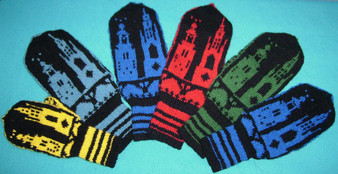Product Description
When fall and winter are about to arrive and nature explodes in red, yellow, orange and gold it is time to pull out your yarn and your knitting needles and stock up your supply of hats, comforters and last but not least - mittens. Inspired by architecture, landmarks, and the city seal, the Örebro mittens were designed as a historical tribute to this city, one of the oldest cities in Sweden.
These two-color mittens where loops are created on the inside with each color change, a layer-upon-layer effect is created where warm air is kept in the small, natural pockets made by the loops, making it warm and cozy even on the coldest of days. Also, a knitted wool mitten will not get cold as fast when wet as a mitten of fabric when wet. These mittens are also washable on the wool program of your washing machine – just remember that they need to air-dry! No dryers etc.
The mittens are knit in Visjögarn, Rauma finull or an equivalent 2-ply wool yarn with approx. 164 yd/50 g.
The story behind the design:
On the cuff there are four stripes of varying length in the color of the pattern; one, two, six and then five rows each. These stripes correspond to the number 1265, which is the year Örebro got its urban privilege.
Directly above the cuff on the right mitten we find the Örebro City Hall, built in 1863. It is located by the city’s largest square; Stortorget, which is also one of Sweden’s longest squares. At Stortorget we also find Saint Nicolai church, also known as the Nikolai church, pictured at the top of the right mittens top side. The building of the Nikolai church started during the second half of the 13th century but was not finished until the mid-14th century. The church has since then undergone some changes, i.e., since its church tower was set on fire by lightning in 1863. Its present look The Nikolai church got during the years 1863-1900.
Directly above the cuff on the left-hand mitten, we find the Örebro Shoe Factory, which was active during the years 1864-1968. Today there are probably not many who are aware that Örebro has been a well-known shoe city in Sverige. Örebro Shoe Factory was the first shoe factory in the Närke province, except for a brief attempt by Carl August Olsson during the years 1874-79.
Above Örebro shoe fabric we find Svartån, a river in Örebro county. Örebro city was founded at the part of Svartån most shallow, where it was possible to wade through the river. There was also an old country road stretching through the country passing at this spot. It made for a strategic choice, and a mart by the river and a harbor near its outlet to lake Hjälmaren was established early on. Later a bridge was built over the shallow parts of Svartån, which rested upon piles av gravel, called “örar”. This was how the city got its name; Örebro.
Above the river Svartån and its boats is the bridge Kanslibron. Its name derives from a chancellery building (chancellery = kansli in Swedish) located at the southeast end of the bridge, built in 1765-66.
At the top of the left-hand mitten, we find Örebro castle. The castle was originally set as a stronghold, probably during the mid-14th century. It is believed that king Magnus Eriksson was the developer. Duke Charles later inherited the building and started a major remodeling in 1573, into what would become Örebro castle, modeled after the Renaissance castles he had visited while in France. The remodeling was not completed until 1625, and the castle has since then undergone several more remodelings.
On the palm of the mittens you may add the year you made the mitten, or perhaps the birthyear of a recipient if your mittens are a gift, along with two bollards. It is said that there are 46 bollards of this type left in Örebro, but some are difficult to find today, as they are encapsuled in vegetation.
The main pattern on the palm of the mittens is the city’s oldest known city seal, from 1331, the spread eagle.
On the thumbs of the mitten the water tower Svampen, opened in May 1958, is depicted. The water tower is 58 meters high and holds 9 million liters of water. On top of the building there is a café and a conference facility.
Sizes: Big medium – Rather large (Please note – large sizing!)
Measurements: (Cuff not included) 7.6”x4.4” – 8.4”x4.8”.
Yarn: Visjögarn or Rauma finull, or an equivalent 2-ply wool yarn with approx. 164 yd/50 g.
Gauge: 30 stitches x 40 rows = 4x4 inches.
Yardage: 164 yd of each color for all sizes.
Needle size: 2 mm and 2.5 mm














